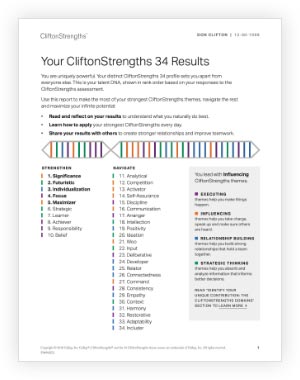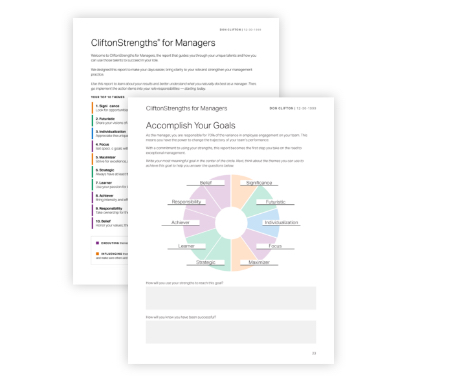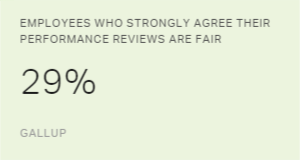Story Highlights
- Only 14% of employees believe performance reviews inspire them to improve
- Focusing on employees' strengths increases their engagement and performance
- Performance issues may be strengths issues in disguise
It's that time of year again -- your annual performance review.
Every year, you are evaluated against a set of performance standards and ratings. And some of those ratings are subject to your manager's idiosyncratic observations. If you are a manager, it's even worse -- after hearing what you need to do to remediate your own shortcomings, you have to repeat the process with your own team and try to fit a year's worth of feedback into a handful of scores.
For decades, performance rating systems have dominated corporate culture in an attempt to provide some way of evaluating and providing feedback to employees.
However, traditional approaches to performance evaluation are deeply flawed and often do more harm than good. For example, only 14% of employees strongly agree that the reviews they receive inspire them to perform better. Only 26% of employees strongly agree that they are accurate, and only 29% strongly agree that they are fair. Not surprisingly, the result is that performance reviews actually make performance worse about one-third of the time.
Gallup research shows there's a better way to manage performance -- one that focuses on improving future performance rather than evaluating and criticizing a person's challenges and shortcomings. Critical elements of this redesigned performance management system distinguish what the employee needs to do from the unique strengths they have to produce the best results.
CliftonStrengths is an excellent way to focus performance conversations on talent, potential and positivity. Here's how to get started integrating a strengths mindset into your approach to performance management:
1. Define success first.
Start by setting clear expectations about what each employee is supposed to accomplish -- what are you paying them to do? Don't rate employees on their ability to pursue results. Rate them on whether they actually produce results. Be comprehensive in defining success -- most employees are asked to do several things.
Only 14% of employees strongly agree that the reviews they receive inspire them to perform better. Only 26% of employees strongly agree that they are accurate, and only 29% strongly agree that they are fair.
One of your most important responsibilities as a leader is to help each employee identify the strengths and partnerships that made them successful in the past. Then, they can use those strengths and partnerships more often to achieve their best work. Even in a new role with different expectations, employees can still use their past experiences to visualize how their strengths will help them succeed. A mindset focused on excellence also makes it easier to discuss other performance expectations and challenges -- how do those scenarios compare with their best work, and how can they play to their strengths more often?
2. Understand that each person is different.
Two of Don Clifton's greatest insights were to recognize that each of us has unique, enduring talents -- and that our greatest room for growth is in those areas of strength.
The most efficient and reliable way for an employee to build mastery in anything is for them to learn their natural talents and develop them into strengths through practice while adding relevant skills and knowledge when necessary.
Over 25 million people have used the CliftonStrengths assessment to identify their dominant talents, and Gallup has found that employees who learn to develop their strengths make their teams and organizations more engaged and productive. They grow their contributions by understanding themselves better, but also by helping their colleagues, managers and customers understand them better.
Good managers understand that their employees have different talents, skills and motivations. Great managers use those differences to maximize employee performance and potential. For example, employees strong in the Communication theme naturally express their thoughts in ways that capture others' attention. They are often able to build thriving relationships through simple conversations.
By contrast, employees strong in the Empathy theme tend to be excellent listeners who build relationships by seeing things from other perspectives. While employees strong in either theme can build strong relationships, they may do so in very different ways that are most authentic to who they are.
Two of Don Clifton's greatest insights were to recognize that each of us has unique, enduring talents -- and that our greatest room for growth is in those areas of strength.
In any role, it's essential to know how one's talents influence behavior, for good or ill. For example, people strong in the Consistency theme might focus so much on uniform processes that they lose sight of the overall goal. The key is for you and your manager to be aware of your potential and your limitations.
3. Include strengths in important work conversations prior to performance reviews.
Gallup has identified five key conversations that managers need to have with their employees regularly:
Role and Relationship
Quick Connect
Check-In
- Developmental Coaching
Progress on Goals
Together, these conversations create a warm, candid, two-way dialogue between managers and employees. This makes tough conversations easier. But it also lays the foundation for deeper, long-term professional development. Knowing an employee's dreams, values and lifestyle constraints are all helpful context for managers.
Managers should weave strengths through all of these conversations. The best thing you can do to improve future performance reviews is to have at least one of these meaningful conversations each week with your team members. Regularly discussing expectations, roadblocks and strengths will quickly transform how work gets done.
4. Help managers think about their own strengths during coaching conversations and performance reviews.
Our own strengths feel natural to us. They are where we are most comfortable doing business. Because they are so intrinsic to who we are, we can be blind to some facets of our strengths when we are coaching others. A manager with the Harmony theme may find it difficult to deliver bad news. On the other hand, someone with the Self-Assurance theme might not always see how their own love of confronting challenges can overpower others.
This doesn't mean that a manager's strengths are bad or that they should have to apologize for who they are. Managers should lean into their own strengths on the job -- but with an understanding of how others might perceive their strengths in action. They should also recognize that how they approach work may not always complement others' unique strengths and approach.
5. Use performance planning that helps employees use their strengths more often.
How often is someone getting to use their strengths? An employee should answer that question with "every day." Gallup has found that people who use their strengths every day are more likely to feel respected, well-rested and that they have enough energy to get things done.
Being engaged in an activity at a deep, intuitive level can result in a sense of flow (i.e., ignoring the clock and giving ourselves fully to the task in front of us). Time not only flies when we're having fun, but also when we are using our strengths. In both cases, a person is less likely to feel stressed or worried about the present or future -- and more likely to feel that their life is meaningful and productive.
Helping employees feel a more personal and meaningful connection with their work is also lucrative. Gallup data show that employees who receive strengths-based development are 8%-18% more productive. So, start your performance conversations by asking, "What are we really trying to do here, and how do we use your strengths to make that happen?" By involving employees in coming up with personalized performance strategies, managers take advantage of employees' expertise in their job and their strengths. They also build trust and respect that will ease hard conversations in the future.
6. Focus feedback on what employees are doing well, rather than on their mistakes.
Many managers believe that performance reviews must be harsh in order to be honest, genuine or meaningful. And as a result, most employees approach performance reviews with dread and anxiety. This is a recipe for unproductive and unhealthy conversations.
Gallup has found that people who use their strengths every day are more likely to feel respected, well-rested and that they have enough energy to get things done.
Certainly, managers should address challenges and concerns. But when they have weekly conversations with employees, they can deal with the challenges in their infancy, rather than letting them fester. The dominant theme of most performance reviews should be what employees do well and how to use that to set expectations for the future. When managers spend more time focused on strengths -- rather than on weaknesses -- during a performance discussion, employees are more than twice as likely to be engaged.
7. Consider how performance issues may be strengths issues in disguise.
People with different strengths see the world differently, and sometimes this causes a breakdown in communications. For example, people with the Activator theme define "right now" as "right now," while those with the Deliberative theme may define it as "after I check out some risks that only I seem to see."
People with different strengths may be motivated by different things or approach unfamiliar situations in different ways. Don't assume that employees see problems, rules or relationships the same way that you do.
Parts of an employee's job may really fit their strengths, but other parts may not. How important are the parts that they struggle with? Is there another way to approach the job that would be a more natural fit for them? Are there skills they could learn that would help them manage difficult parts of their job?
8. Focus on the future instead of dwelling on the past.
One reason traditional performance reviews are so unpleasant is that they often focus on past mistakes that cannot be fixed or changed, and feedback is given far too late. If performance reviews only happen once a year, an employee has little opportunity to learn and make corrections when feedback is most relevant. This is demotivating and disheartening for employees.
One reason traditional performance reviews are so unpleasant is that they often focus on past mistakes that cannot be fixed or changed.
Focusing on goal progress and opportunities for development throughout the year is more motivating for employees than merely critiquing past performance a few times per year. People learn best through a constant loop of real-life experience and timely feedback.
Focusing on the future also encourages employees and managers to adapt goals as their work priorities change. Setting and adapting those goals together will help the employee develop more ownership and continually clarify what success looks like. With their manager's help, an employee will also set more realistic, practical goals.
One simple but powerful question to ask is, "How do you think you can use your strengths to achieve your goal?"
9. As much as possible, recraft roles, tasks and responsibilities to fit strengths.
We describe the expectations of a job in a way that makes sense to us. We emphasize those interesting or exciting parts of a job -- as we define them. But don't assume every employee will be attracted to or repelled by the same aspects of the role.
A manager with high relational strengths might see a job as primarily social -- they see the expectations, fun and success of a role through relationships. However, they might be onboarding someone who has more thinking or analytical themes. For them, problem-solving and complexity are intrinsically motivating, and the social aspects may be less attractive.
10. Review team strengths and partnerships.
Gallup uses a tool called a Team Strengths Grid to help managers and team members see the top strengths of each person and the collective team. Take a look at your team, and find ways for people with complementary strengths to collaborate. Specialization allows both people to spend more time doing what each does best and allows them to tackle challenges together that neither could alone.
You may notice that one or two employees have very different strengths than the rest of the team. They may say that they feel a bit like outsiders. And yet these people may offer the vital magic that makes an exceptional team -- if everyone on the team sees their unique abilities and appreciates them.
Strong partnerships also help build a more lasting commitment to the organization. Employees with just one collaborative relationship are 29% more likely to say they will stay with their employer for the next year, and 42% more likely to intend to stay for their entire career.
The best managers help team members learn to play to each other's strengths, alongside their own.
11. Give personalized recognition tailored to an employee's strengths.
There's nothing more rewarding than knowing that you contributed to the success of the team -- and that only you had the unique gifts to do it. We become immune to frequent and generic praise over time. We also don't like praise for average or subpar performance. Gallup's research shows that recognition should be frequent but based on true excellence and targeted toward strengths.
Determine the kind of praise that means the most to each person on your team. Someone with the Significance theme may want recognition from as many people as possible. While someone with the Relator theme may prefer something more intimate -- a one-on-one conversation or a handwritten note.
Gallup's research shows that recognition should be frequent but based on true excellence and targeted toward strengths.
Unlock employee motivation, starting with strengths.
Many management systems are designed to ignore as much of the variability and individuality among employees as possible. But it's a mistake to assume that there is only one way to do a job "correctly" and that, therefore, every employee will need to succeed in the same exact way.
Beginning a performance review by discussing an employee's strengths sends a very different message. Most people prefer to talk about what they like to do. And steering the discussion toward what they naturally do well (as opposed to what they do poorly) builds a better relationship between managers and employees.
The discussion during the review focuses on how employees can use their unique talents to perform their role with strength, and it helps managers understand the many possible ways of achieving a successful outcome.
Done correctly, a strengths-based performance review will make what the organization means by "success" much clearer -- and whether the employee is succeeding. It also helps build the connection between the employee and manager that is necessary for engagement. Finally, it should help managers understand how to motivate employees to do their best. It's one thing to know what we do well; it's another thing entirely to do it to the best of our ability every day.
Bring strengths into your conversations:
- Subscribe to the CliftonStrengths Insights newsletter to learn more about leading with strengths.
- Discover how to overcome some of the greatest challenges of management, including frustrating performance reviews.
- Read How to Create a Strengths-Based Company Culture for more ways to integrate strengths into performance conversations.






